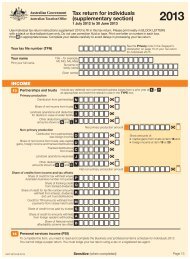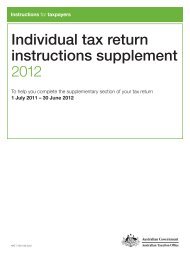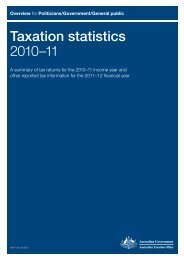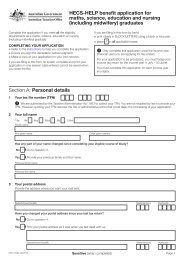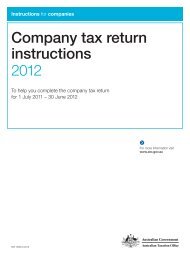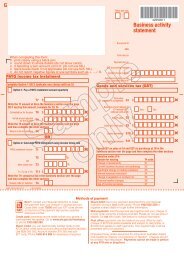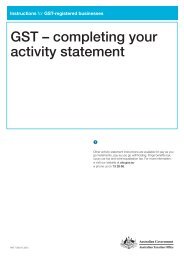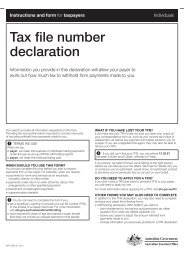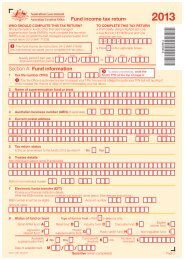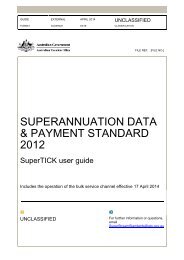Guide to depreciating assets 2013 - Australian Taxation Office
Guide to depreciating assets 2013 - Australian Taxation Office
Guide to depreciating assets 2013 - Australian Taxation Office
You also want an ePaper? Increase the reach of your titles
YUMPU automatically turns print PDFs into web optimized ePapers that Google loves.
Similar rules apply <strong>to</strong> the second element of a <strong>depreciating</strong>asset’s cost. For example, if something is done <strong>to</strong> improveyour <strong>depreciating</strong> asset under a private or domesticarrangement, the second element of the asset’s cost is themarket value of the improvement when it is made.The market value may need <strong>to</strong> be reduced for any input taxcredits <strong>to</strong> which you would have been entitled; see GST inputtax credits on the previous page.Note that there are special rules for working out the effectivelife and decline in value of a <strong>depreciating</strong> asset acquired froman associate, such as a spouse or partner; see Depreciatingasset acquired from an associate on page 9.Depreciating asset acquired with other propertyIf you pay an amount for a <strong>depreciating</strong> asset and somethingelse, only that part of the payment that is reasonablyattributable <strong>to</strong> the <strong>depreciating</strong> asset is treated as beingpaid for it. This applies <strong>to</strong> first and second elements of cost.Apportionment on the basis of the market values ofthe various items for which the payment is made willgenerally be reasonable.EXAMPLE: Apportionment of costSam undertakes <strong>to</strong> pay an upholsterer $800 for a newdesk and $300 <strong>to</strong> re-upholster a chair in a more durablematerial. He negotiates a trade discount of $100.The $1,000 paid should be apportioned between:n the first element of cost of the desk, andn the second element of cost of the chairbased on the relative market values of the desk andthe labour and materials used <strong>to</strong> upholster the chair.Hire purchase agreementsFor income tax purposes, certain hire purchase agreementsentered in<strong>to</strong> after 27 February 1998 are treated as notionalsale and loan transactions.If the goods subject <strong>to</strong> the hire purchase agreementare <strong>depreciating</strong> <strong>assets</strong> and the hirer is the holder of the<strong>depreciating</strong> <strong>assets</strong> (see Depreciating <strong>assets</strong> subject <strong>to</strong>hire purchase agreements on page 4) the hirer may beentitled <strong>to</strong> deductions for the decline in value. Generally,the cost or value stated in the hire purchase agreemen<strong>to</strong>r the arm’s length value is taken <strong>to</strong> be the cost of the<strong>depreciating</strong> <strong>assets</strong>.Death of the holderIf a <strong>depreciating</strong> asset starts being held by you as a legalpersonal representative (say, as the execu<strong>to</strong>r of an estate)as a result of the death of the former holder, the cost of theasset <strong>to</strong> you is generally its adjustable value on the day theformer holder died.If the former holder allocated the asset <strong>to</strong> a low-value pool,the cost of the asset <strong>to</strong> you is the amount of the closingbalance of the pool for the income year in which the formerholder died that is reasonably attributable <strong>to</strong> the asset;see Low-value pools on page 22.If you start <strong>to</strong> hold a <strong>depreciating</strong> asset because it passes<strong>to</strong> you as a beneficiary of an estate or as a surviving jointtenant, the cost of the asset <strong>to</strong> you is its market value whenyou started <strong>to</strong> hold it reduced by any capital gain that wasignored when the owner died or when it passed from thelegal personal representative. See the <strong>Guide</strong> <strong>to</strong> capital gainstax <strong>2013</strong> (NAT 4151) for information about when these gainscan be disregarded.Commercial debt forgivenessGenerally, an amount that you owe is a commercial debt if youcan claim a deduction for the interest paid on the debt or youwould have been able <strong>to</strong> claim a deduction for interest if it hadbeen charged. The amount of the commercial debt includesany accrued but unpaid interest.If a commercial debt is forgiven, you may be required <strong>to</strong>make a reduction for a <strong>depreciating</strong> asset. If a reduction of theamount of deductible expenditure is made for a <strong>depreciating</strong>asset, the asset’s cost is reduced by the debt forgivenessamount. If the reduction is made in a year later than the onein which the asset’s start time occurs, the opening adjustablevalue of the asset is also reduced.If an asset’s opening adjustable value is reduced and you usethe prime cost method <strong>to</strong> work out the asset’s decline in value,you need <strong>to</strong> use the adjusted prime cost formula for the incomeyear that the change is made and in later years; see Methodsof working out decline in value on page 6.Recoupment of costIf you recoup an amount that you had previously included inthe cost of a <strong>depreciating</strong> asset, you may need <strong>to</strong> include thatrecouped amount in your assessable income. An amount youreceive for the sale of a <strong>depreciating</strong> asset at market value isnot an assessable recoupment.Foreign currency gains and lossesIf you purchased a <strong>depreciating</strong> asset in foreign currency,the first element of the asset’s cost is converted <strong>to</strong> <strong>Australian</strong>currency at the exchange rate applicable when you began <strong>to</strong>hold the asset, or when the obligation was satisfied, whicheveroccurred first. From 1 July 2003, if the foreign currencyamount became due for payment within the 24-month periodthat began 12 months before the time when you began <strong>to</strong> holdthe <strong>depreciating</strong> asset, any realised foreign currency gain orloss (referred <strong>to</strong> as a forex realisation gain or a forex realisationloss) can modify the asset’s cost, the opening adjustable value,or the opening balance of your low-value pool (as the casemay be). Otherwise, that gain or loss is included in assessableincome or allowed as a deduction, respectively.If the foreign currency amount relates <strong>to</strong> the second elemen<strong>to</strong>f the cost of a <strong>depreciating</strong> asset, the translation <strong>to</strong> <strong>Australian</strong>currency is made at the exchange rate applicable at the timeyou incurred the relevant expenditure, and the 12-month ruleapplies instead of the 24-month rule. The 12-month rulerequires that the foreign currency became due for paymentwithin 12 months after the time you incurred the relevantexpenditure. In some circumstances you may be able <strong>to</strong>elect that forex gains and losses do not modify the asset’scost, the opening adjustable value or the opening balanceof your low‐value pool. For more information, see Foreignexchange (forex): election out of the 12 month rule (NAT 9344),at a<strong>to</strong>.gov.au16 a<strong>to</strong>.gov.au GUIDE TO DEPRECIATING ASSETS <strong>2013</strong>



